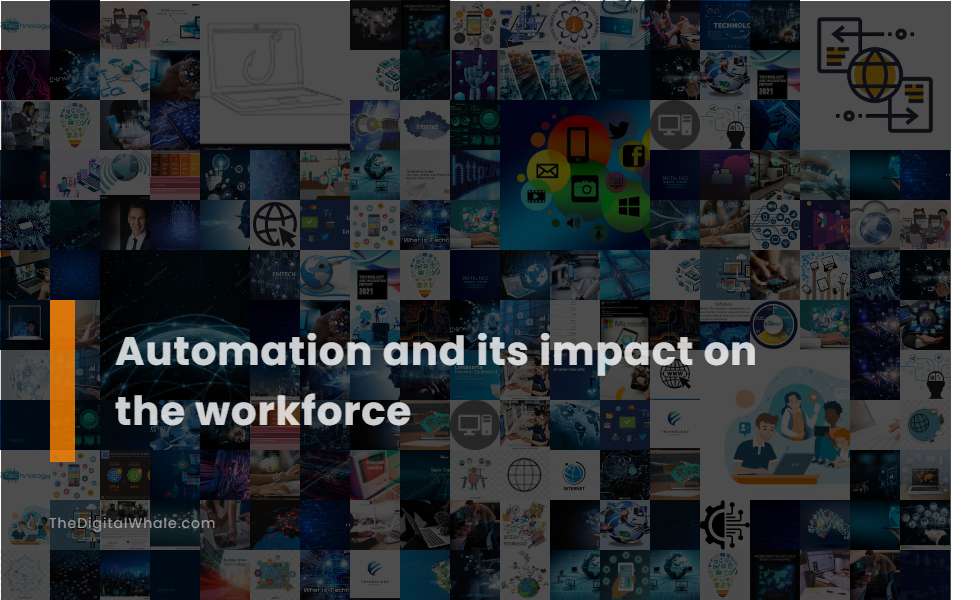Automation and Its Impact On the Workforce
What are the effects of automation on workers, jobs, and wages? What are some of the negative effects automation has on the workforce in businesses? Let's find out more about Automation and Its Impact On the Workforce.

Job Displacement
The integration of AI and automation into the workforce has sparked significant debate regarding its impact on employment across various sectors. While it's undeniable that automation can lead to job displacement, particularly in roles involving routine, repetitive, or manual tasks, the outcome is far from uniform. Experts suggest that, alongside displacement, automation also creates new job opportunities and enhances job quality by eliminating monotonous tasks. Although AI may displace millions of jobs globally by 2030, including roles in finance, healthcare, and legal services, it's also projected to create a surplus of roles, thus emphasizing the importance of adapting the workforce through upskilling initiatives. This shift, forecasted to reshape up to 85 million jobs worldwide by 2025, necessitates ethical considerations and strategic planning to alleviate potential negative impacts. It's crucial to understand the full spectrum of https://linvelo.com/the-job-displacement-dilemma/ and implement effective retraining programs to bridge the skills gap, ensuring workers maintain employability in this evolving landscape.
Increased Efficiency
Automation significantly enhances efficiency by automating manual and repetitive tasks, which enables employees to concentrate on more strategic and value-added activities, thereby improving productivity, accuracy, and overall organizational performance. By integrating Workforce Automation, companies can streamline operations, allowing staff to engage in higher-value work and achieve a better work-life balance through effective workload management, as further highlighted by the impact of AI-powered automation on workforce dynamics and job roles.
Skill Gap
The adoption of automation and AI is poised to significantly widen the skill gap across industries, with a growing demand for technological, social, and emotional skills, while the necessity for physical and manual tasks diminishes. This transformation necessitates widespread retraining and upskilling efforts within the workforce to remain competitive. As industrial automation progresses, the Industry 4.0 skills gap emerges as a pivotal challenge, requiring workers to gain advanced competencies to adeptly manage and navigate new technologies. Bridging this gap is crucial to ensuring innovation, competitiveness, and economic growth in the modern era. Automation is expected to not only eliminate jobs that can be easily automated but also create new roles requiring 21st-century skills such as communication, complex analytical abilities, and creativity. For a comprehensive understanding of how these shifts will impact the workforce, [McKinsey's analysis on the future of work](https://www.mckinsey.com/featured-insights/future-of-work/skill-shift-automation-and-the-future-of-the-workforce) emphasizes the urgent need for enhanced education and training programs to equip workers with the skills necessary to thrive in the evolving job landscape.
Economic Impact
Automation has a dual economic impact; it increases productivity and reduces costs, leading to lower prices and potentially creating new jobs, but it also displaces workers, particularly those in roles that can be substituted by machines, and exacerbates labor market inequality by shifting compensation from workers to business owners. For a deeper analysis of these effects, you can explore the Impact of Automation on Workers, which discusses these dynamics in detail.
Industry Transformation
Automation in the workforce can transform industries by creating new economic opportunities, promoting regionalized manufacturing, and providing rewarding career pathways, but it requires collaborative efforts from public and private sectors to retrain and upskill the labor force. The balance between workforce and automation in the industrial and manufacturing sector involves strategic change management, reskilling and upskilling workers, and embracing AI and Automation to enhance productivity and efficiency, rather than replacing human labor entirely.
Related:
What is the impact of the Internet of Things? What are the implications of the Internet of Things for business? Let's find out more about The Internet of Things and Its Implications.
Remote Work Integration
As the future of work continues to evolve, automation in remote work plays a key role by integrating AI and automation to streamline workflows, boost productivity, and enhance collaboration. This allows teams to focus on higher-value tasks while maintaining efficiency and scalability in both hybrid and fully remote setups. Furthermore, Workforce Automation helps bridge the gap between in-office and remote employees by increasing efficiency, scalability, and innovation. It enables businesses to manage increased workloads without additional hiring, thereby fostering a more flexible and efficient work environment.
AI and Machine Learning
AI-powered automation is significantly altering workforce dynamics by transforming mundane tasks, evolving current job roles, and fostering new tech-focused job opportunities. This revolution emphasizes the critical need for upskilling in both technical and soft skills to boost productivity and ensure a balanced work-life experience. The landscape is further shaped by AI's potential to disrupt the labor market through automation, particularly impacting lower-paying positions, yet simultaneously creating new roles and enhancing overall productivity. This leads to predictions of a net positive job growth and substantial increase in global GDP. As noted by Data Science Central, there is a consistent impact on low-skill, routine jobs, while white-collar tasks are transformed, enhancing productivity and opening new career paths in advanced fields like machine learning and natural language processing. This underscores the essential requirement for ongoing employee training and adaptation in this rapidly changing landscape.
Automation Costs
Automation costs are primarily driven by the need to reduce labor expenses, with firms that automate witnessing higher wage bill growth in 2023. However, these firms expect a deceleration in wage bill growth moving into 2024, and anticipate employment growth to be about 1.5 percentage points slower compared to their non-automating counterparts. Overall, while automation reduces production costs and enhances competitiveness in various industries, it demands substantial initial investments in machinery and maintenance. These investments can offset some of the long-term benefits derived from reduced labor costs and increased productivity. For a more detailed insight into the impact of automation on employment, the Federal Reserve Bank of Richmond provides a comprehensive analysis on their website.
Worker Retraining
In the age of automation, worker retraining has become crucial, with strategies encompassing continuous training, employer-sponsored programs, and partnerships with local stakeholders to provide essential on-the-ground training and certification. This approach helps workers transition to more technical roles that are less vulnerable to automation. As companies prioritize bridging skills gaps, initiatives like Amazon's Upskilling 2025 exemplify the commitment to enhance employee productivity and align with organizational missions. Moreover, companies such as Stanley Black & Decker are also following similar paths. For more insights into how technology can lead reskilling efforts during this transformative period, visit the World Economic Forum website for comprehensive strategies and case studies in this evolving landscape.
Ethical Considerations
The rise of automation in the workplace introduces significant ethical considerations, such as job displacement, erosion of human dignity, and the potential exacerbation of income inequality. It is crucial to establish ethical frameworks, promote transparency, and engage with stakeholders to ensure that technological advancements align with human rights and well-being. As automation disproportionately affects low-income and marginalized workers, it can widen social inequalities. To address these challenges, policies such as retraining programs and fair distribution of productivity benefits are essential. Exploring the ethical implications of AI and other emerging technologies, the website Sogeti Labs discusses the need for careful consideration in the development and deployment of AI technologies to prevent further socioeconomic inequalities.
Related:
What is the definition of artificial intelligence? What is artificial intelligence and what does it do? Let's find out more about The Rise of Artificial Intelligence.
